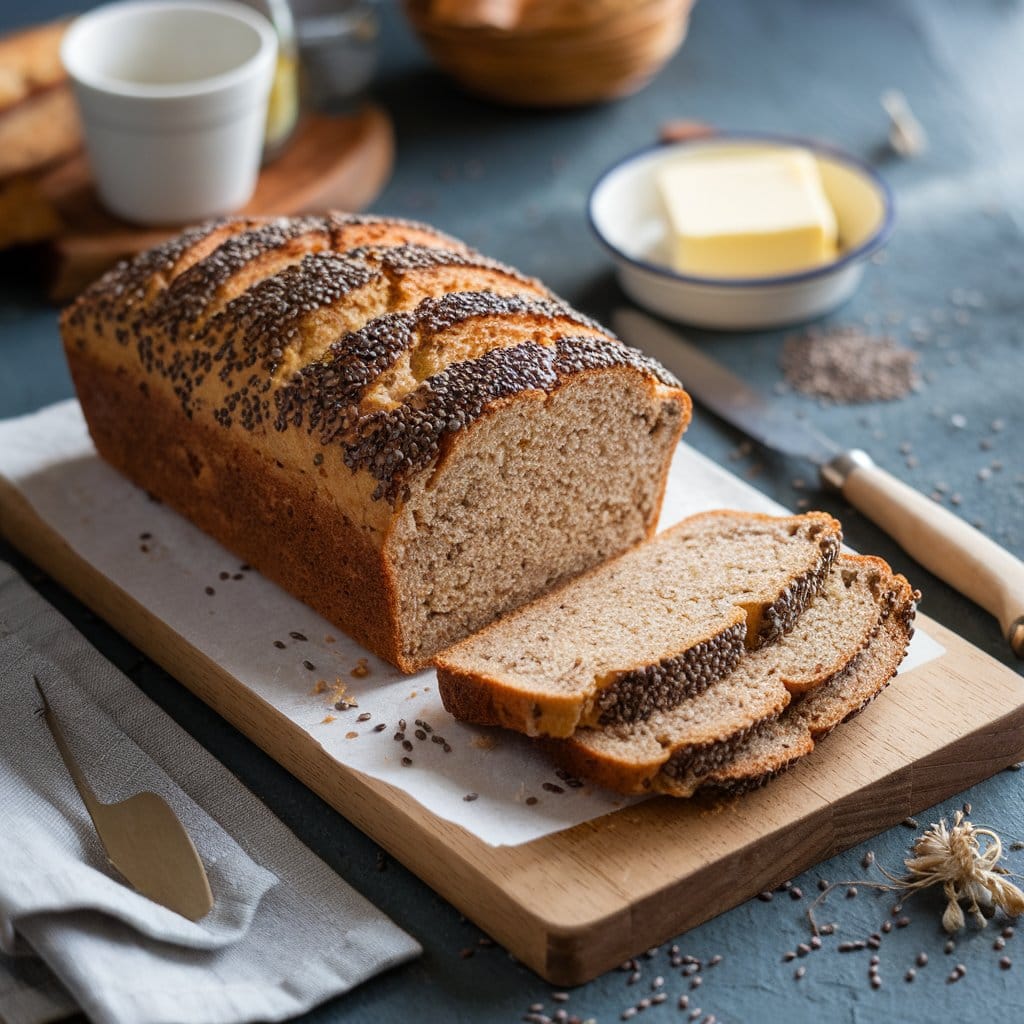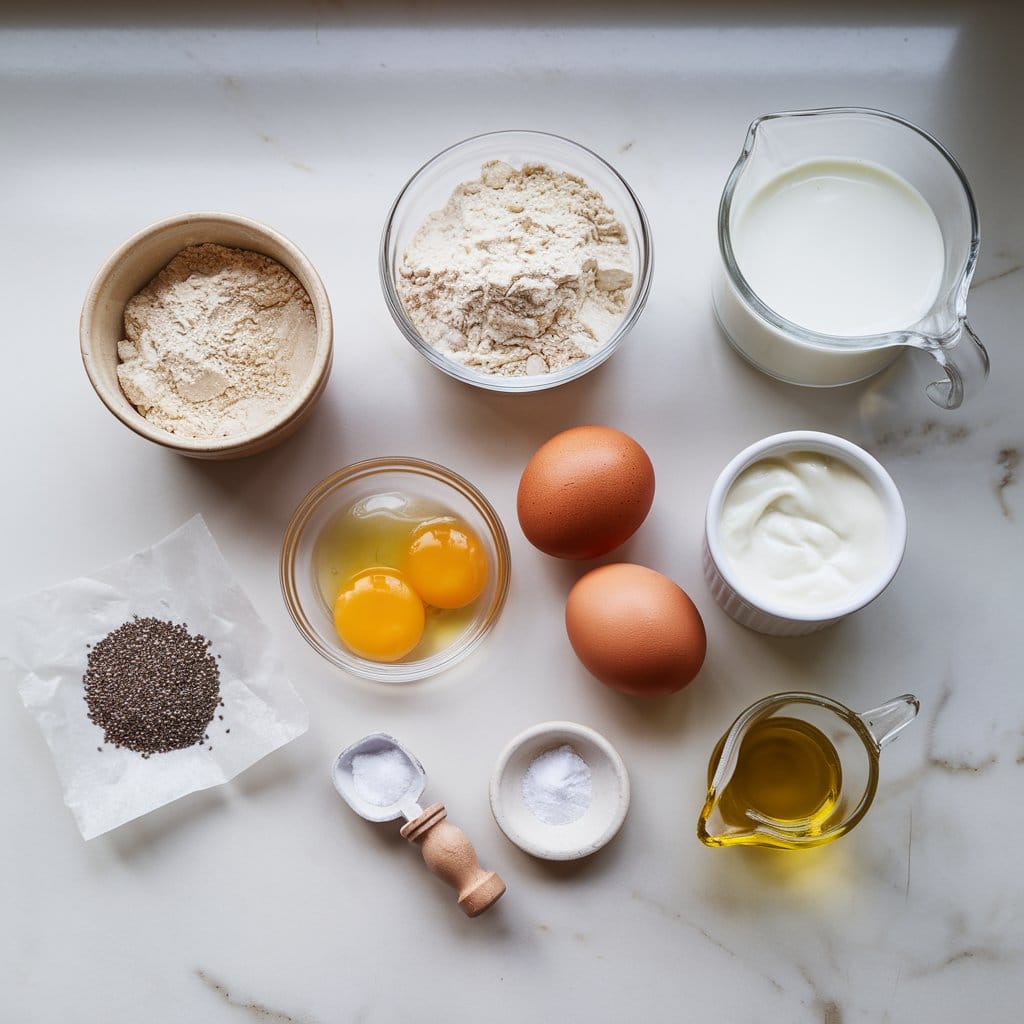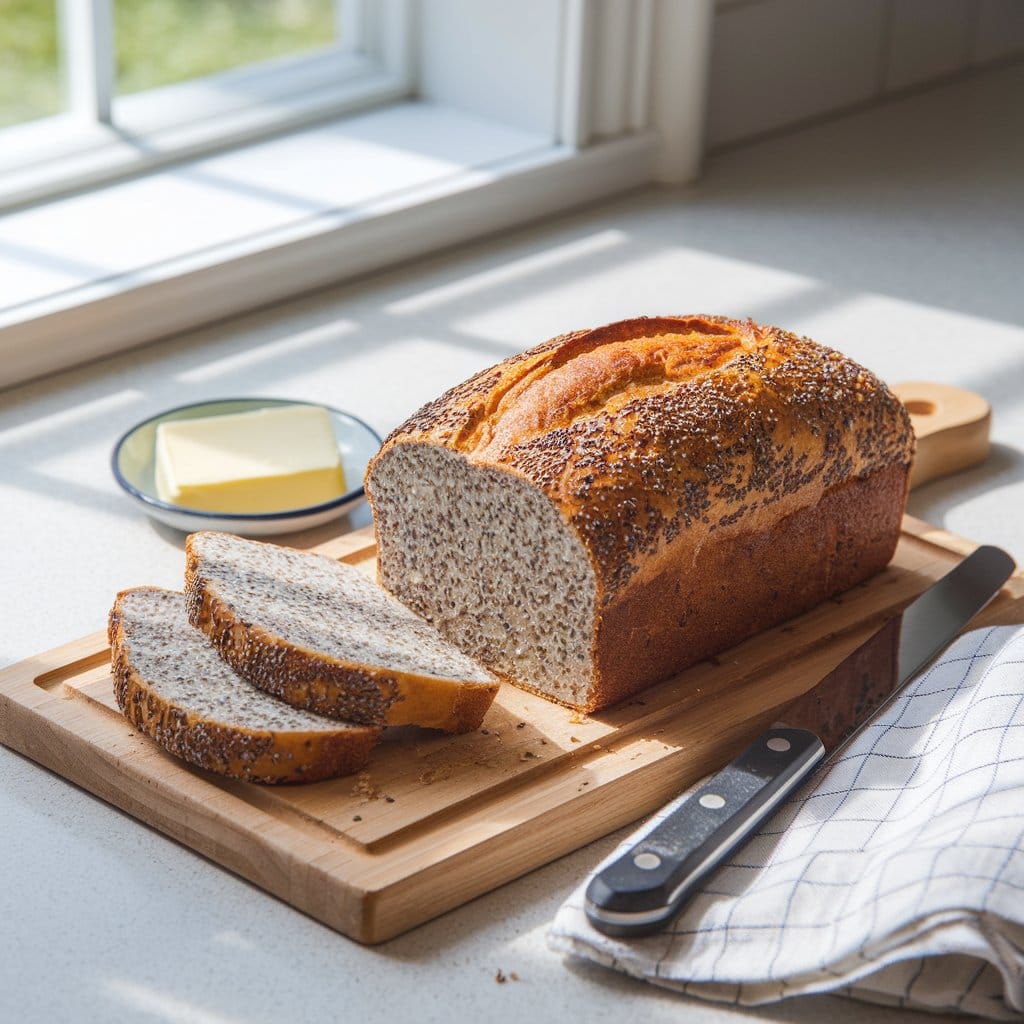Table of Contents
What Is Protein Bread?
Protein bread is exactly what it sounds like—bread packed with protein! It’s the perfect balance between indulgence and nutrition. Instead of relying solely on traditional wheat flour, this bread incorporates protein-rich ingredients like almond flour, whey protein, or even seeds like chia and flax. It’s a modern twist on your classic loaf, designed to fuel your body and satisfy your cravings.
Why Protein Bread Is a Healthy Alternative
Why should you ditch your regular bread for protein bread? Well, imagine this: you’re eating your favorite sandwich, but instead of just filling up on carbs, you’re feeding your muscles with every bite. That’s the magic of protein bread. It’s low in carbs and high in protein, making it a fantastic option for fitness enthusiasts, busy parents, or anyone looking for a healthier diet.

The Growing Popularity of Protein-Enriched Foods
Protein-packed foods have taken the world by storm, and protein bread is no exception. Thanks to fitness trends like keto and low-carb diets, people are searching for alternatives that keep them full without sacrificing their health goals. Protein bread has become a kitchen superstar—just ask the countless Instagram posts featuring homemade loaves!
Benefits of Including Protein Bread in Your Diet
So, what’s in it for you? A lot, actually:
- High Protein Content: Perfect for building and repairing muscles. Whether you’re a gym lover or just want to stay strong, this bread has got your back.
- Low-Carb and Weight-Loss Friendly: Want to cut carbs but can’t give up bread? Protein bread is your savior.
- Gluten-Free Options: Many recipes swap traditional wheat for almond or coconut flour, making them safe for those with gluten sensitivities.
Common Problems When Making Protein Bread at Home
Let’s face it: baking isn’t always smooth sailing. When it comes to protein bread, you might hit a few bumps:
- Dense Texture: Ever tried making bread and ended up with something as heavy as a brick? Protein-rich flours can make your bread dense if you don’t get the balance right.
- Lack of Flavor: Plain protein bread can taste, well, plain. Don’t worry; we’ll jazz it up with some flavor boosters later.
- Trouble Achieving a Perfect Rise: Without gluten, getting that fluffy texture can be tricky. But hey, it’s all about the right technique.
- Dryness: Too much protein powder and too little moisture can leave you with a dry loaf. Nobody wants that!
Pro Tip: Don’t be discouraged by these challenges! Once you master the basics, baking protein bread is a breeze.
Key Ingredients for a Perfect Protein Bread Recipe
Here’s your dream team for crafting the ultimate protein bread:
| Ingredient | Why It’s Important |
|---|---|
| Protein Powder | The star of the show—whey, pea, or soy work great. |
| Almond or Coconut Flour | Gluten-free and low-carb, perfect for structure. |
| Eggs | Adds moisture and helps bind everything together. |
| Greek Yogurt | Keeps the bread soft and adds a tangy flavor. |
| Baking Powder | The unsung hero—this makes your bread rise. |
Protein Bread Recipe
Time to roll up your sleeves! Let’s bake:
Ingredients:

| Ingredient | Quantity |
|---|---|
| Protein Powder | 1/2 cup |
| Almond Flour | 1 cup |
| Eggs | 3 large |
| Greek Yogurt | 1/2 cup |
| Baking Powder | 1 tsp |
| Olive Oil | 2 tbsp |
| Salt | 1/4 tsp |
| Optional Sweetener | 1-2 tbsp |
Instructions:
- Preheat Your Oven: Set it to 350°F (175°C) to ensure even baking.
- Prepare Dry Ingredients: In a mixing bowl, combine:
- Protein powder
- Almond flour
- Baking powder
- Salt
- Prepare Wet Ingredients: In a separate bowl:
- Whisk the eggs until well beaten.
- Mix in the Greek yogurt and olive oil until smooth.
- Combine Ingredients:
- Gradually add the wet mixture into the dry mixture.
- Mix gently and patiently until a uniform batter forms.
- Optional Sweetener: If you prefer a slightly sweet bread, add your choice of sweetener at this stage.
- Bake the Bread:
- Grease a loaf pan to prevent sticking.
- Pour the batter into the pan evenly.
- Bake for 30-40 minutes, keeping an eye on it to avoid overbaking.
- Cool Before Slicing:
- Allow the bread to cool in the pan for 5-10 minutes.
- Transfer to a cooling rack and let it rest completely before slicing.
Pro Tips:
- Texture Tip: Overmixing can make the bread dense. Mix just enough to combine.
- Doneness Test: Insert a toothpick into the center; if it comes out clean, the bread is ready.
- Storage: Store in an airtight container or refrigerate to keep it fresh.
Nutritional Benefits of Protein Bread
| Nutrient | Per Slice |
|---|---|
| Calories | ~120 |
| Protein | 10g |
| Carbs | 5g |
| Fats | 6g |
| Fiber | 2g |
Creative Variations to Try
- Vegan Protein Bread: Swap eggs for flaxseed meal and use plant-based protein powder.
- Keto Protein Bread: Skip the sweetener and use more almond flour for an ultra-low-carb option.
- High-Fiber Bread: Add chia seeds or psyllium husk for extra fiber.
Creative Ways to Enjoy Protein Bread
Protein bread isn’t just a loaf; it’s a blank canvas for creativity! Here are some mouthwatering ideas to make every slice shine:
- Nut Butter & Fruits: Spread almond or peanut butter on a slice and top it with banana slices or berries. The mix of protein, healthy fats, and natural sugars makes for a perfect snack or breakfast.
- Savory Sandwiches: Layer turkey, avocado, and a slice of cheese for a protein-packed lunch. Or try smoked salmon with cream cheese and a sprinkle of dill—classic and classy.
- Croutons for Salads: Cut your bread into cubes, toast them with olive oil and herbs, and boom—you’ve got protein-rich croutons to level up your salad game.
- Protein French Toast: Dip slices in a mixture of eggs, cinnamon, and a splash of almond milk, then pan-fry until golden. Top with sugar-free syrup or fresh fruits for a guilt-free treat.
Tips to Store and Preserve Protein Bread
Keeping your protein bread fresh is as important as making it. Here’s how to do it:
- Room Temperature: If you’re planning to eat it within 2-3 days, wrap it tightly in plastic wrap or store it in an airtight container. Keep it in a cool, dry place.
- Refrigeration: For longer shelf life (up to a week), refrigerate your bread. Wrap it in parchment paper and store it in a resealable bag to prevent moisture loss.
- Freezing: Protein bread freezes beautifully! Slice the loaf before freezing, so you can defrost only what you need. Wrap individual slices in cling film and store them in a freezer bag. It’ll stay good for up to 3 months.
Pro Tip: To refresh frozen slices, pop them in the toaster or oven for a couple of minutes.
Variations of Protein Bread Recipes
One size doesn’t fit all, and the same goes for recipes. Here are some variations to suit different needs:
- Vegan Protein Bread: Use plant-based protein powder and replace eggs with flax or chia seeds.
- Keto-Friendly Protein Bread: Stick to almond and coconut flour with no added sweeteners.
- High-Fiber Protein Bread: Throw in a handful of chia seeds, psyllium husk, or ground flaxseed for an extra dose of fiber.
Protein bread is an excellent option for those seeking a high-protein, healthy alternative to traditional bread. If you’re looking to explore more protein-rich recipes, consider checking out the detailed guide on High Protein Bread Recipe, which offers insights into achieving the perfect loaf every time. For those on a gluten-free diet, these Gluten-Free Protein Pancakes make a fantastic breakfast option. Additionally, don’t miss out on learning about the nutritional benefits of Protein Bread as a Healthy Alternative, which dives deeper into why this trend has taken the health world by storm.

Nutrition Facts: A Quick Recap
Here’s a snapshot of the nutritional perks of protein bread. These values are approximate and can vary depending on your recipe:
| Nutrient | Per Slice |
|---|---|
| Calories | ~120 |
| Protein | 10g |
| Carbs | 5g |
| Fats | 6g |
| Fiber | 2g |
FAQs About Protein Bread Healthy Recipe
1. What is Protein Bread?
Protein bread is a type of bread enriched with protein-rich ingredients such as protein powder, almond flour, or seeds. It’s designed to provide more nutritional value than regular bread, especially for those looking to increase protein intake while reducing carbs.
2. Is Protein Bread Healthy?
Yes! Protein bread is a healthier alternative to traditional bread. It’s high in protein, often lower in carbohydrates, and can be customized to include healthy fats and fibers. However, the health benefits depend on the specific ingredients used.
3. Can I Make Protein Bread Without Special Equipment?
Absolutely! You don’t need any fancy tools. A mixing bowl, whisk, and loaf pan will do the trick. If you have a food processor or a stand mixer, it can make the process even easier.
4. What Are the Key Ingredients in Protein Bread?
The main ingredients typically include:
- Protein powder (whey, pea, or soy)
- Almond or coconut flour
- Eggs (or vegan alternatives like flaxseed meal)
- Greek yogurt or similar binders
- Baking powder These ingredients are combined to create a loaf that’s high in protein and low in carbs.
5. Is Protein Bread Gluten-Free?
It can be! Many protein bread recipes use almond or coconut flour instead of wheat flour, making them naturally gluten-free. Be sure to check the ingredients, especially if you have gluten intolerance or celiac disease.
6. Can I Freeze Protein Bread?
Yes, protein bread freezes very well. Slice the loaf before freezing, wrap each slice in cling film, and store them in a freezer-safe bag. Defrost individual slices as needed for convenience.
7. Does Protein Bread Taste Good?
The taste depends on the recipe and ingredients. While some find protein bread slightly denser than traditional bread, adding herbs, spices, or sweeteners can enhance the flavor. Experimenting with toppings like avocado or nut butter can also elevate its taste.
8. How Do I Prevent Protein Bread from Being Too Dry?
Protein-rich flours and powders can sometimes lead to dryness. To prevent this:
- Use ingredients like Greek yogurt or eggs for added moisture.
- Avoid overbaking.
- Add a splash of olive oil or a touch of honey to improve texture and flavor.
Conclusion: Embrace the Health Benefits of Protein Bread
Protein bread isn’t just a trend—it’s a lifestyle upgrade. It’s versatile, delicious, and a game-changer for anyone looking to add more protein to their diet without sacrificing flavor. Whether you’re a fitness enthusiast, a busy parent, or just someone who loves good food, protein bread deserves a spot in your kitchen.
So, what are you waiting for? Grab your ingredients, roll up your sleeves, and start baking! Once you’ve mastered the basics, don’t hesitate to experiment with flavors and variations. Who knows? You might create the next viral protein bread recipe.
